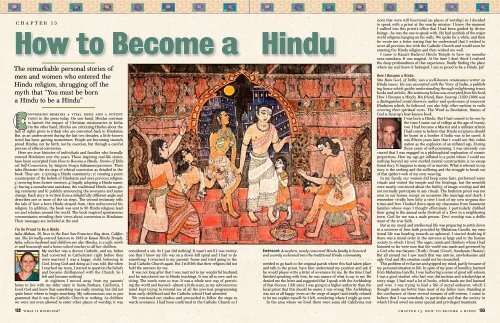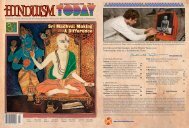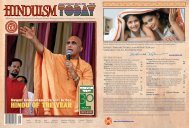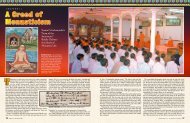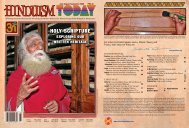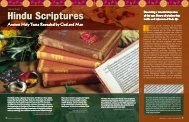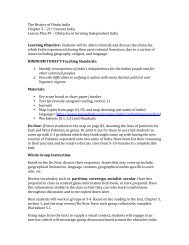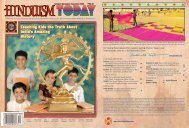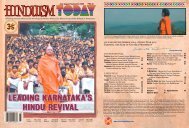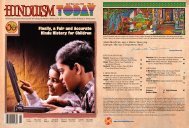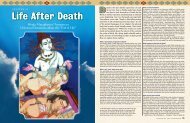Join the Hindu - Hinduism Today Magazine
Join the Hindu - Hinduism Today Magazine
Join the Hindu - Hinduism Today Magazine
Create successful ePaper yourself
Turn your PDF publications into a flip-book with our unique Google optimized e-Paper software.
c h a p t e r 1 3How to Become a <strong>Hindu</strong>The remarkable personal stories ofmen and women who entered <strong>the</strong><strong>Hindu</strong> religion, shrugging off <strong>the</strong>myth that “You must be borna <strong>Hindu</strong> to be a <strong>Hindu</strong>”Conversion remains a vital issue and a potenttopic in <strong>the</strong> press today. On one hand, <strong>Hindu</strong>s continueto lament <strong>the</strong> impact of Christian missionaries in India.On <strong>the</strong> o<strong>the</strong>r hand, <strong>Hindu</strong>s are criticizing <strong>Hindu</strong>s about <strong>the</strong>lack of rights given to tribals who are converted back to <strong>Hindu</strong>ism.But, as an undercurrent during <strong>the</strong> last two decades, a little-knowntrend has been gaining momentum. People are becoming staunch,proud <strong>Hindu</strong>s, not by birth, not by coercion, but through a carefulprocess of ethical conversion.Here are true histories of individuals and families who formallyentered <strong>Hindu</strong>ism over <strong>the</strong> years. These inspiring real-life storieshave been excerpted from How to Become a <strong>Hindu</strong>: Stories of EthicalSelf-Conversion, by Satguru Sivaya Subramuniyaswami. Theirtales illustrate <strong>the</strong> six steps of ethical conversion as detailed in <strong>the</strong>book. They are: 1) joining a <strong>Hindu</strong> community; 2) creating a pointcounterpointof <strong>the</strong> beliefs of <strong>Hindu</strong>ism and one’s previous religion;3) severing from former mentors; 4) legally adopting a <strong>Hindu</strong> name;5) having a namakarana samskara, <strong>the</strong> traditional <strong>Hindu</strong> name-givingceremony and 6) publicly announcing <strong>the</strong> severance and namechange. Each story is written from a delightfully different angle anddescribes one or more of <strong>the</strong> six steps. The second testimony tells<strong>the</strong> tale of how a born <strong>Hindu</strong> strayed from, <strong>the</strong>n rediscovered hisreligion. In addition, <strong>the</strong> book was sent to 86 <strong>Hindu</strong> religious leadersand scholars around <strong>the</strong> world. The book inspired spontaneouscommentaries revealing <strong>the</strong>ir views about conversion to <strong>Hindu</strong>ism.Their messages are included at <strong>the</strong> end.I’m So Proud to Be a <strong>Hindu</strong>Asha Alahan, 50, lives in <strong>the</strong> East San Francisco Bay Area, California.She formally entered Saivism in 1985 at Kauai <strong>Hindu</strong> Temple.Asha, whose husband and children are also <strong>Hindu</strong>s, is a wife, mo<strong>the</strong>rand housewife and a home-school teacher to all her children.My mo<strong>the</strong>r was a devout Catholic, and my fa<strong>the</strong>rhad converted to Catholicism right before <strong>the</strong>ywere married. I was a happy child, believing inGod, loving God and doing as I was told. But whenI reached my teens, I started to question <strong>the</strong> beliefsand became disillusioned with <strong>the</strong> Church. So Ileft and became nothing!At eighteen I moved away from my parents’home to live with my older sister in Santa Barbara, California. Iloved God and knew that something was really missing, but did notquite know where to begin searching. My subconscious was so programmedthat it was <strong>the</strong> Catholic Church or nothing. As childrenwe were not even allowed to enter o<strong>the</strong>r places of worship; it was132 what is hinduism?s. rajamconsidered a sin. So I just did nothing! It wasn’t until I was twentyonethat I knew my life was on a down-hill spiral and I had to dosomething. I returned to my parents’ home and tried going to <strong>the</strong>local Catholic Church again. But I still felt that <strong>the</strong>ir religion did nothold <strong>the</strong> answers for me.It was not long after that I was married to my wonderful husband,and he introduced me to <strong>Hindu</strong> teachings. It was all so new and exciting.The words were so true. It was a whole new way of perceiving<strong>the</strong> world and beyond—almost a little scary, as my subconsciousmind kept trying to remind me of all <strong>the</strong> previous programmingfrom early childhood and <strong>the</strong> Catholic school I had attended.We continued our studies and proceeded to follow <strong>the</strong> steps towardsseverance. I had been confirmed in <strong>the</strong> Catholic Church so IEmbraced: A modern, newly converted <strong>Hindu</strong> family is honoredand warmly welcomed into <strong>the</strong> traditional <strong>Hindu</strong> communityneeded to go back to <strong>the</strong> original parish where this had taken placeand talk to <strong>the</strong> priest, have him understand my position and ask ifhe would please write a letter of severance for me. By <strong>the</strong> time I hadfinished speaking with him, he was unsure of what to say to me. Hedenied me <strong>the</strong> letter and suggested that I speak with <strong>the</strong> Archbishopof that diocese. I felt since I was going to a higher authority than <strong>the</strong>local priest that this should be easier. I was wrong. The Archbishopwas not at all happy (even on <strong>the</strong> verge of anger) and totally refusedto let me explain myself. So I left, wondering where I might go next.In <strong>the</strong> area where we lived <strong>the</strong>re were some old California missionsthat were still functional (as places of worship) so I decidedto speak with a priest at <strong>the</strong> nearby mission. I knew <strong>the</strong> momentI walked into this priest’s office that I had been guided by divinebeings—he was <strong>the</strong> one to speak with. He had symbols of <strong>the</strong> majorworld religions hanging on his walls. We spoke for a while, and <strong>the</strong>nhe wrote me a letter stating that he understood that I wished tosever all previous ties with <strong>the</strong> Catholic Church and would soon beentering <strong>the</strong> <strong>Hindu</strong> religion and <strong>the</strong>n wished me well.I came to Kauai’s Kadavul Hin du Temple to have my namakaranasamskara. It was magical. At <strong>the</strong> time I don’t think I realized<strong>the</strong> deep profoundness of that experience, finally finding <strong>the</strong> placewhere my soul knew it belonged. I am so proud to be a <strong>Hindu</strong>. Jai!How I Became a <strong>Hindu</strong>Sita Ram Goel, of Delhi, was a well-known renaissance writer on<strong>Hindu</strong> issues. He was associated with <strong>the</strong> Voice of India, a publishinghouse which guides understanding through enlightening tracts,books and articles. His testimony below was excerpted from his book,How I Became a <strong>Hindu</strong>. His friend, Ram Swarup (1920-1998) wasa distinguished social observer, author and spokesman of renascent<strong>Hindu</strong>ism which, he believed, can also help o<strong>the</strong>r nations in rediscovering<strong>the</strong>ir spiritual roots. The Word as Revelation, Names ofGod is Swarup’s best-known book.I was born a <strong>Hindu</strong>. But I had ceased to be one by<strong>the</strong> time I came out of college at <strong>the</strong> age of twentytwo.I had become a Marxist and a militant a<strong>the</strong>ist.I had come to believe that <strong>Hindu</strong> scriptures shouldbe burnt in a bonfire if India was to be saved. Itwas fifteen years later that I could see this culminationas <strong>the</strong> explosion of an inflated ego. Duringthose years of self-poisoning, I was sincerely convincedthat I was engaged in a philosophical exploration of cosmicproportions. How my ego got inflated to a point where I could seenothing beyond my own morbid mental constructions is no exceptionalstory. It happens to many of us mortals. What is relevant in mystory is <strong>the</strong> seeking and <strong>the</strong> suffering and <strong>the</strong> struggle to break outof that spider’s web of my own weaving.In my family, our women did keep some fasts, performed somerituals and visited <strong>the</strong> temple and <strong>the</strong> Sivalinga, but <strong>the</strong> menfolkwere mostly convinced about <strong>the</strong> futility of image worship and didnot normally participate in any rituals. The brahmin priest was notseen in our homes, except on occasions like marriage and death. Iremember vividly how lofty a view I took of my own nirguna doctrinesand how I looked down upon my classmates from Sanatanistfamilies whose ways I thought effeminate. I particularly disliked<strong>the</strong>ir going to <strong>the</strong> annual mela (festival) of a Devi in a neighboringtown. God for me was a male person. Devi worship was a defilementof <strong>the</strong> true faith.But as my moral and intellectual life was preparing to settle downin a universe of firm faith provided by Mahatma Gandhi, my emotionallife was heading towards an upheaval. I started doubting if<strong>the</strong>re was a moral order in <strong>the</strong> universe at large and in <strong>the</strong> humansociety in which I lived. The sages, saints and thinkers whom I hadhonored so far were sure that <strong>the</strong> world was made and governed bya God who was Satyam (Truth), Sivam (Good), Sundaram (Beauty).But all around me I saw much that was untrue, unwholesome andugly. God and His creation could not be reconciled.This problem of evil arose and gripped my mind, partly because ofmy personal situation in life. In spite of my pose of humility, learnedfrom Mahatma Gandhi, I was harbor ing a sense of great self-esteem.I was a good student who had won distinctions and scholarships atevery stage. I had read a lot of books, which made me feel learnedand wise. I was trying to lead a life of moral endeavor, which Ithought made me better than most of my fellow men. Standing at<strong>the</strong> confluence of <strong>the</strong>se several streams of self-esteem, I came tobelieve that I was somebody in particular and that <strong>the</strong> society inwhich I lived owed me some special and privileged treatment.chapter 13: how to become a hindu 133
Now I was in a desperate hurry to get a good knowledge of <strong>the</strong>doctrine of socialism. A desire to read Karl Marx now became irresistible.First, I read <strong>the</strong> Communist Manifesto. It was simplybreathtaking in <strong>the</strong> breadth and depth of its sweep over vast vistasof human history. It was also a great call to action, to change <strong>the</strong>world and end exploitation and social injustice for all time to come.At <strong>the</strong> same time I concluded that God as a creator of this worldcould be conceived only in three ways—ei<strong>the</strong>r as a rogue who sanctionedand shared in <strong>the</strong> roguery prevalent in his world, or as an imbecilewho could no more control what he had created, or as a sannyasin,who no more cared for what was happening to his creatures. IfGod was a rogue, we had to rise in revolt against his rule. If he was animbecile, we could forget him and take charge of <strong>the</strong> world ourselves.And if he was a sannyasin, he could mind his business while we mindedour own. The scriptures, however, held out a different version ofGod and his role, one that was supported nei<strong>the</strong>r by experience norby logic. The scriptures should, <strong>the</strong>refore, be burned in a bonfire,preferably during winter when <strong>the</strong>y could provide some warmth.Four years after leaving college, I was ready to join <strong>the</strong> Com munistParty of India. I conveyed my decision to my friend Ram Swarup,whom I had met after leaving college and who was to exercise adecisive influence on my intellectual evolution. He wrote back immediately:“You are too intelligent not to become a communist. Butyou are also too intelligent to remain one for long.”This was a prophecy which came true. It was only a year and a fewmonths later that I renounced Marxism as an inadequate philosophy,realized that <strong>the</strong> Communist Party of India was a fifth column for<strong>the</strong> advancement of Russian Imperialism in India, and denounced<strong>the</strong> Soviet Union under Stalin as a vast slave empire.The promise made by Sri Aurobindo, on <strong>the</strong> o<strong>the</strong>r hand, regarding<strong>the</strong> ultimate destiny of <strong>the</strong> human race was far more stupendousthan that held out by Marx. Howsoever vague and inchoate my visionmight have been at that time, I did feel that Sri Aurobindo was talkingabout fundamentally different dimensions of <strong>the</strong> universe andhuman life. The gulf between my mundane interests and <strong>the</strong> grandaspirations dictated by Sri Auro bindo’s vision was very wide, and Icould hardly muster <strong>the</strong> care or <strong>the</strong> courage to cross over. But in <strong>the</strong>inner recesses of my mind, I did become curious about <strong>the</strong> natureof <strong>the</strong> universe, man’s place in it and a meaningful goal of human life.I was present in <strong>the</strong> Second Party Conference of <strong>the</strong> CommunistParty of India which was held in <strong>the</strong> Maidan at Calcutta inFebruary, 1948. My friend Ram Swarup suddenly appeared on <strong>the</strong>scene and expressed his intention to stay with me for quite sometime. I was very happy because he was my nearest and dearestin <strong>the</strong> whole world. I did not know that he had by now come toregard communism as a great evil threatening to engulf <strong>the</strong> futureof mankind. After I failed to put my three best communist friendsagainst Ram Swarup, I had to face him myself and all alone. Thediscussions spread over several months. Most of <strong>the</strong> time I repeatedparty slogans, sometimes very vehemently. Ram Swarup dismissed<strong>the</strong>m with a smile.Finally, I was back to square one. My faith in Gandhism had lost<strong>the</strong> battle to Marxism. Now I was no longer a Marxist. I asked myselfagain and again: Where do I go from here?It was at this time that I fell seriously ill and lost a lot of weight.A Catholic missionary whom I had known earlier came to visit me.He was a good and kindly man and had a strong character. TheFa<strong>the</strong>r, as I called him, found me in a difficult condition, physicallyas well as financially. He felt sure that it was in such times that JesusChrist came to people. He asked me if I was prepared to receiveJesus. I did not understand immediately that he was inviting me toget converted to Catholicism. My impression was that he wanted tohelp me with some spiritual exercises prescribed by Christianity.Moreover, I had always admired Jesus. I had, <strong>the</strong>refore, no objectionto receiving him. Only I was doubtful if someone was really in aposition to arrange my meeting with Jesus. I became aware of <strong>the</strong>Fa<strong>the</strong>r’s true intentions as I traveled with him to a distant monastery.134 what is hinduism?s. rajamHe asked every o<strong>the</strong>r missionary he met on <strong>the</strong> way to pray for hissuccess.At this monastery, which was a vast place with very picturesquesurroundings, I was advised by <strong>the</strong> Fa<strong>the</strong>r to go into a retreat. Itmeant my solitary confinement to a room. I was not supposed tolook at or talk to anyone on my way to <strong>the</strong> bathrooms or while takingmy morning and evening strolls on <strong>the</strong> extensive lawns outside. AndI was to meditate on <strong>the</strong>mes which <strong>the</strong> Fa<strong>the</strong>r prescribed for mein <strong>the</strong> course of four or five lectures he delivered to me during <strong>the</strong>course of <strong>the</strong> day, starting at about 6:30 in those winter mornings. Iwas not used to this way of life. I had never lived in such solitude bymy own choice. My only solace was that I was allowed to smoke andprovided with plenty of books on <strong>the</strong> Christian creed and <strong>the</strong>ology.I tried to read some of <strong>the</strong> books, but I failed to finish any one of<strong>the</strong>m. They were full of Biblical <strong>the</strong>mes and <strong>the</strong>ological terminologywith which I was not familiar. Most of <strong>the</strong> time <strong>the</strong>y made me recallRam Swarup’s observation about mere cerebration. Or <strong>the</strong>y weresimplistic harangues to love Christ and join <strong>the</strong> Catholic Church.They had a close similarity to com mun ist pamphlets which I hadread in plenty. The Fa<strong>the</strong>r had asked me again and again to invokeChrist and meditate upon him. But he had not told me how to doit. I had no previous practice in meditation. I did not know how toinvoke Christ, or any o<strong>the</strong>r godhead for that matter.During a lecture about creation, <strong>the</strong> Fa<strong>the</strong>r said that God in Hiswisdom and kindness had made all fishes and animals and birdsfor man’s consumption. I immediately rose in revolt. I told him veryemphatically that I was a Vaishnava and a vegetarian and that Ihad absolutely no use for a God that bestowed upon man <strong>the</strong> rightto kill and eat His o<strong>the</strong>r creatures simply because man happenedto be stronger and more skilled. I added that in my opinion it was<strong>the</strong> duty of <strong>the</strong> strong and <strong>the</strong> more skilled to protect <strong>the</strong> weak and<strong>the</strong> less wily.The Fa<strong>the</strong>r also suddenly lost his self-possession. He almost shouted:“I can never understand you <strong>Hindu</strong>s who go about seeking asoul in every lice and bug and cockroach that crawls around you.The Bible says in so many words that man is God’s highest creation.What is wrong with <strong>the</strong> higher ruling over <strong>the</strong> lower?”On our way back to <strong>the</strong> big city where his mission was housed, hebecame his old normal self again. There was not a trace of bitternesson his face or in his voice as we talked and joked and discussedseveral serious and not so serious matters. Now I took my courage inboth my hands and asked him my final question: “Fa<strong>the</strong>r, am I notalready a Christian? I do not normally tell a lie. I do not steal. I donot bear false witness. I do not covet my neighbor’s wife or property.What more can a man do to demand God’s grace and kinship withChrist? Why should you insist on a formal conversion which in noway helps me to become better than what I am?” His reply was verypositive and it estranged me from <strong>the</strong> Christian creed for good. Hesaid: “It is an illusion that you can become a Christian if you practiceChristian virtues. One cannot claim to be virtuous unless onePassage: Entering <strong>Hindu</strong>ism often brings a change in culture, fromWestern materialism to Asian refinement, a process depicted at leftby a lady’s stepping through a magic portal, leaving her old worldand entering a new oneis baptized in <strong>the</strong> Church of Christ. He is <strong>the</strong> only savior. No oneoutside His fold can claim salvation. The only thing <strong>the</strong> hea<strong>the</strong>nscan look forward to is eternal hell-fire.”My new job in Delhi gave me a lot of leisure. But what matteredmost was that I could now spend all my evenings with Ram Swarup.He was now spending long hours sitting in meditation. His talksnow centered round <strong>the</strong> Vedas, <strong>the</strong> Upa nishads, <strong>the</strong> Gita, <strong>the</strong> Mahabharataand <strong>the</strong> Buddha. In <strong>the</strong> long evenings I spent with RamSwarup I compared with him my notes on <strong>the</strong> Mahabharata. ButRam Swarup’s way of looking at <strong>the</strong> Mahabharata was quite different.He related it directly to <strong>the</strong> Vedas. He expounded how <strong>the</strong>mighty characters of this great epic embodied and made living <strong>the</strong>spiritual vision of <strong>the</strong> Vedic seers. What fascinated me still morewas Ram Swarup’s exposition of dharma as enunciated in <strong>the</strong> Mahabharata.To me, dharma had always been a matter of normativemorals, external rules and regulations, do’s and dont’s, enforced onlife by an act of will. Now I was made to see dharma as a multidimensionalmovement of man’s inner law of being, his psychic evolution,his spir itual growth and his spontaneous building of an outerlife for himself and <strong>the</strong> community in which he lived.The next thing I did was to read and reread <strong>the</strong> major works ofAurobindo and discuss his message with Ram Swarup day after day.Aurobindo would have remained an abstract philosopher for me hadnot Ram Swarup explained to me how this seer was <strong>the</strong> greatestexponent of <strong>the</strong> Vedic vision in our times. Aurobindo’s message, hetold me, was in essence <strong>the</strong> same old Vedic message, namely, thatwe are Gods in our innermost being and should live <strong>the</strong> life of Godson this Earth. He made me see what Aurobindo meant by <strong>the</strong> physical,<strong>the</strong> vital, <strong>the</strong> mental and <strong>the</strong> psychic. He related <strong>the</strong>se terms to<strong>the</strong> <strong>the</strong>ory of <strong>the</strong> five kosas in <strong>the</strong> Upanishads.I now requested Ram Swarup to initiate me into meditation. Hetold me that I could sit and meditate with him whenever I liked,wait and watch, go within myself as far as I could manage, at anytime, dwell on whatever good thoughts got revealed in <strong>the</strong> process,and <strong>the</strong> rest would follow. I acted upon his simple instructions withsome measure of skepticism in my mind. But in <strong>the</strong> next few days Icould see some results, which encouraged me.One day I meditated on ahimsa, which had remained an abstractconcept for me so far. After a while I found myself begging forgivenessfrom all those whom I had hurt by word or deed, or towardswhom I had harbored any ill will. It was not an exercise in generalities.Person after person rose into my memory, going back into <strong>the</strong>distant past and I bowed in repentance before each one of <strong>the</strong>m.Finally I begged forgiveness from Stalin, against whom I had writtenso much and upon whom I had hurled so many brickbats. Thebit terness which had poisoned my life over <strong>the</strong> long years was sweptoff my mind in a sudden relaxation of nerves. I felt as if a thousandthorns which had tormented my flesh had been taken out by a masterphysician without causing <strong>the</strong> slightest pain. I was in need of nogreater assurance that this was <strong>the</strong> way on which I should walk.One day I told Ram Swarup how I had never been able to accept<strong>the</strong> Devi, ei<strong>the</strong>r as Sarasvati or as Lakshmi or as Durga or as Kali.He smiled and asked me to meditate on <strong>the</strong> Devi that day. I triedmy best in my own way. Nothing happened for some time. Nothingcame my way. My mind was a big blank. But in <strong>the</strong> next moment <strong>the</strong>void was filled with a sense of some great presence. I did not see anyconcrete image. No words were whispered in my ears. Yet <strong>the</strong> rigidityof a lifetime broke down and disappeared. The Great Mo<strong>the</strong>r wasbeckoning her lost child to go and sit in her lap and feel safe fromall fears. We had a record of Dr. Go vind Gopal Mukho padhyaya’ssonorous stuti to <strong>the</strong> Devi. As I played it, I prayed to Her.My progress was not fast; nor did I go far. But I now felt sure thatchapter 13: how to become a hindu 135
From <strong>the</strong> Masonic Order and Roman CatholicismShyamadeva and Peshanidevi Dandapani, both age 60, live in Anchorage,Alaska. Shyamadeva is a commercial real estate brokerspecializing in site acquisitions and leasing for local, regional andnational real estate clients. Peshanidevi is a retired nurse, “domesticengineer” and homemaker.We pilgrimaged to Kauai in November of 1994 forKrittika Dipam. During this pilgrimage, we trulybegan to embrace <strong>the</strong> Sanatana Dharma and returnedhome to Alaska to talk to our family andfriends about becoming <strong>Hindu</strong>s, and to beginmerging with <strong>the</strong> <strong>Hindu</strong> community in Anchorage.For <strong>the</strong> most part, everyone was tolerant of our enthusiasmabout becoming <strong>Hindu</strong>s.We had already leased out our house in preparation for moving toKauai, so we rented an apartment, continued our studies and began<strong>the</strong> conversion and severance process. It was our in-depth study toreview our lives, to determine our true beliefs, where <strong>the</strong>y camefrom and if <strong>the</strong>y were still valid for us. There were many rewritesand surprises. We returned to our previous influences (myself to<strong>the</strong> Freemasons and Peshani devi to <strong>the</strong> Catholic Church), studyingand participating with <strong>the</strong>m again to be positive that we wantedto change our path. I returned to <strong>the</strong> Masonic Lodge and fully embracedFreemasonry for <strong>the</strong> next thirty days. I attended <strong>the</strong> lodgeand participated fully in all its ceremonies and rituals. At <strong>the</strong> end of<strong>the</strong> thirty days, I was completely convinced that I no longer held <strong>the</strong>inherent beliefs of <strong>the</strong> Masonic Order. Even with all <strong>the</strong> years of beinga very active Mason I knew it was nei<strong>the</strong>r my belief nor my path.The Masons say, “Once a Mason, always a Mason.” The only way tosever <strong>the</strong> vows was to become a self-imposed apostate. I prepareda letter declaring that I was a self-imposed apostate to <strong>the</strong> Masonicvows and beliefs, and that I was converting fully to <strong>Hindu</strong>ism. I read<strong>the</strong> letter in open lodge before all <strong>the</strong> members present and a copywas given to <strong>the</strong> secretary to be recorded into <strong>the</strong> minutes of <strong>the</strong>meeting on June 8, 1995, at Kenai Lodge No. 11.Peshanidevi returned to <strong>the</strong> Midwest to attend mass and meetwith <strong>the</strong> priest who had given her instructions for being baptized aCatholic. Two hours of discussion did not produce a letter of release,because, he said, “Once a Catholic, always a Catholic.” He took itvery personally but promised a letter to follow. A month later it arrived(above left). The fire was strong but <strong>the</strong> bond was broken.We applied for our legal name change and announced it in <strong>the</strong>newspapers. On <strong>the</strong> auspicious day of July 9, 1995, in Kadavul Hinthiswas <strong>the</strong> method by which I could rediscover for myself <strong>the</strong> greattruths of which <strong>the</strong> ancients had spoken in <strong>Hindu</strong> scriptures. It wasnot <strong>the</strong> end of my seeking, which had only started in right earnest.But it was surely <strong>the</strong> end of my wandering in search of a shorewhere I could safely anchor my soul and take stock of my situation.The soul’s hunger for absolute Truth, absolute Good, absoluteBeauty and absolute Power, I was told, was like <strong>the</strong> body’s hungerfor wholesome food and drink. And that which satisfied this hungerof <strong>the</strong> human soul, fully and finally, wasSanatana Dharma, true for all times andclimes. A votary of Sanatana Dharma didnot need an arbitrary exercise of will toput blind faith in a supernatural revelationlaid down in a single scripture. Hedid not need <strong>the</strong> inter mediacy of a historicalprophet nor <strong>the</strong> help of an organizedchurch to attain salvation. SanatanaDharma called upon its votary to explorehis own self in <strong>the</strong> first instance and seefor himself <strong>the</strong> truths expounded in sacredscriptures. Prophets and churchesand scriptures could be aids, but never<strong>the</strong> substitutes for self-exploration, selfpurificationand self-transcendence.I had come back at last, come backto my spiritual home from which I hadwandered away in self-forgetfulness. Butthis coming back was no atavistic act. On<strong>the</strong> contrary, it was a reawakening to myancestral heritage, which was waitingfor me all along to lay my claim on itslargesses. It was also <strong>the</strong> heritage of allmankind, as proved by <strong>the</strong> seers, sagesand mystics of many a time and clime. Itspoke in different languages to differentpeople. To me it spoke in <strong>the</strong> language of<strong>Hindu</strong> spirituality and <strong>Hindu</strong> culture at<strong>the</strong>ir highest. I could not resist its call. Ibecame a <strong>Hindu</strong>.My Whole Family Became <strong>Hindu</strong>sIsani Alahan, 52, (photo at right) lived inChennai, India, for several years, whereshe worked in <strong>the</strong> home, cooking SouthIndian ayurvedic meals for her family of five, and did home-schoolingwith her youngest daughter. She also studied Carnatic music,Sanskrit, hatha yoga and <strong>the</strong> Kerala health system known as Kalaripayattu.She returned with her family to live in Kauai in June,2000.I was introduced to <strong>Hindu</strong>ism in 1970 through a local hatha yogaclass in Carson City, Nevada. As time went on, I read more aboutyoga and <strong>the</strong> wonderful benefits for <strong>the</strong> body and mind. At this timeI decided to become a vege tar ian. I was sixteen years old. In 1972my interest in meditation manifested. I attended weekly satsanga inVirginia City, Nevada. During <strong>the</strong> first satsanga, I had a memorablevision of Lord Siva Nataraja on <strong>the</strong> banks of <strong>the</strong> sacred Ganga. Mylife had changed.In 1975 I married my husband of 25 years. My husband was acceptingof my beliefs, but wasn’t interested in studying. I continuedon my own, and in 1980 I legally changed my name to Isani Alahanfrom Ardith Jean Barton, but kept my husband’s last name, Pontius.In December of 1982 I completed my conversion to <strong>Hindu</strong>ism. Iprepared a statement of apostasy and took it to <strong>the</strong> local priest. Helooked at it and agreed to sign my formal release from <strong>the</strong> CatholicChurch. As I took a deep sigh of relief, he hesitated and asked meto leave <strong>the</strong> room. When I returned, he had changed his mind. Hetold me he had called <strong>the</strong> Bishop in Reno and was told he could not136 what is hinduism?ananda vikadanAcceptance and release: (above) Isani Alahan’sfamily was featured on <strong>the</strong> cover of a Tamilmagazine during <strong>the</strong>ir stay in Chennai, SouthIndia. Clockwise: husband Durvasa, Isani, Priya,Neesha and Sitara. (right) The letter of release forPeshanidevi Dandapani reveals <strong>the</strong> angst manypastors feel when confronted with conversion outof <strong>the</strong>ir church.sign <strong>the</strong> paper. Later I learned this was not true, and <strong>the</strong> Bishophad been out of town. I tried ano<strong>the</strong>r priest in <strong>the</strong> town where Iwas born. He was understanding, but also declined. Within a fewweeks, I called <strong>the</strong> Bishop to make an appointment to meet withhim. He told me to go back to <strong>the</strong> original priest, who would signmy declaration of apostasy. I returned to <strong>the</strong> local rectory and met apriest of Chinese descent. He was very warm and accommodating.He explained how he understood <strong>the</strong> <strong>Hindu</strong> concept of ethical conversion.He signed my declaration andwished me <strong>the</strong> best.I had my namakarana samskara atKauai’s <strong>Hindu</strong> Temple on December25, 1982, with my two-year-old daughter,Neesha. Then we were off for sixweeks of pilgrimage, visiting templesand ashrams throughout Ma lay sia, SriLanka and Tamil Nadu, India. It wasa fantastic spiritual experience thatcontinues to reverberate in my mind.At <strong>the</strong> time, my husband was not a<strong>Hindu</strong>, but our three daughters weregiven <strong>Hindu</strong> first names at birth, whilekeeping his family name. We raised <strong>the</strong>children according to <strong>Hindu</strong> Dharmaand our guru’s guidance. In 1984 wemoved to <strong>the</strong> Seattle area. During <strong>the</strong>ten years we lived in Seattle, my childrenand I ga<strong>the</strong>red with <strong>the</strong> o<strong>the</strong>r local<strong>Hindu</strong>s for weekly satsanga. We alsomet with <strong>the</strong> local <strong>Hindu</strong> community forfestivals. We studied Bharata Natyamand Carnatic vocal music. My childrenattended <strong>Hindu</strong> summer camps in Hawaii.All through <strong>the</strong>se years, with hispermission, I prayed that my husbandwould become a <strong>Hindu</strong>. Then, in 1993my husband formally adopted <strong>Hindu</strong>ism,legally changed his name from VictorDean Pontius to Durvasa Alahan. Hebecame a vegetarian, stopped smokingand gave up catch-and-release fishing,which was his favorite hobby. He had hisnamakarana samskara in 1994.In November, 1996, my husband and eldest daughter went on pilgrimageto India for a month. My daughter was interested in studyingBharata Natyam, and my husband left my daughter in Indiaso that she could attend Kalakshetra College of Fine Arts and geta diploma in Bharata Natyam. She started college in June of 1997,and <strong>the</strong> rest of <strong>the</strong> family, my husband, myself and two youngerdaughters, moved to Chennai, Tamil Nadu, in November of 1997.The past three years have had <strong>the</strong>ir moments of difficulty, but overall<strong>the</strong>y have been a peak experience of my life, a fulfillment of myheart’s desires.My Husband and I and Our Lifelong QuestAmala Seyon, 58, entered <strong>Hindu</strong>ism in May, 1975. A homemakeron Kauai, she and her husband live within walking distance of <strong>the</strong>Kadavul <strong>Hindu</strong> Temple.My first introduction to <strong>Hindu</strong>ism was when I metmy husband. He had been going through a verysoul-searching time, asking God why <strong>the</strong> Vietnamwar, why <strong>the</strong> rioting in <strong>the</strong> streets of America, andwhat does materialism have to offer <strong>the</strong> soul?While going through this trying time and praying,a born <strong>Hindu</strong> man came to his world religion classand talked about <strong>the</strong> <strong>Hindu</strong> religion. All <strong>the</strong> con-courtesy peshanidevi dandapanicepts of <strong>Hindu</strong>ism were <strong>the</strong> truths my husband was looking for. This<strong>Hindu</strong> man had a meditation center and invited anyone in <strong>the</strong> classto come. My husband started going on a regular basis.During this time, my husband asked me to marry him. He explainedto me about <strong>the</strong> <strong>Hindu</strong> religion and took me to <strong>the</strong> meditationcenter. I was so happy to hear some of <strong>the</strong> concepts, like Godis within you, <strong>the</strong> law of karma, <strong>the</strong> evolution of <strong>the</strong> soul. I felt like Ihad been in a cage, like a bird, and someone opened <strong>the</strong> door, and Iwas able to fly into something much bigger and deeper.My husband told me that if we got married this was <strong>the</strong> path hewanted us to take. I accepted that and supported it fully. This started<strong>the</strong> process of a confrontation of Western and Eastern philosophies.Our first encounter was in finding someone to marry us. Myhusband went to <strong>the</strong> <strong>Hindu</strong> meditation center and asked this saintlyman if he could marry us. His visa did not allow him to perform <strong>the</strong>ceremony. So we went to my family’s Christian minister and askedhim to marry us. He asked my husband a series of questions. Doyou believe Jesus Christ is <strong>the</strong> only Son of God? Do you believe that<strong>the</strong> Holy Bible is <strong>the</strong> only word of God? The questioning went on forsome time, and at <strong>the</strong> end of <strong>the</strong> interview he told my husband thatnot only could he not marry us but he was going to call my parentsand tell <strong>the</strong>m that he was against having me marry someone whowas not a Christian.We <strong>the</strong>n had to confront my mo<strong>the</strong>r, who was very much a Christian.This was all emotionally hard for her because of <strong>the</strong> beliefthat you could only be saved through <strong>the</strong> belief in Jesus Christ. Shewas very disappointed, and <strong>the</strong> issue caused a major disruption inour family. Finally, <strong>the</strong>y accepted our marriage, and my husbandlocated his past minister, who agreed to marry us.After our marriage, we started reading all we could on <strong>Hindu</strong>ism.My husband mistakenly followed <strong>the</strong> statements in <strong>Hindu</strong> scripturethat we now realize were intended for monks. We sold and gaveaway all our wedding gifts and went to live in very remote areas ofBritish Columbia. He read from morning until night and sat by ariver for hours on end, but we finally realized we were not makingreal spiritual progress, and I was lonely living in remote areas andeven on a deserted island.We started searching and praying, and one day someone invitedus to meet our Gurudeva, Sivaya Subramuniya swami. We recognizedwhat a great soul he was immediately, and we started ourstudies with him. When our two daughters were five and threeyears old, we all had our name-giving toge<strong>the</strong>r, formally entering<strong>the</strong> <strong>Hindu</strong> religion.My children were raised in <strong>the</strong> <strong>Hindu</strong> religion, and we spent alot of years living near <strong>the</strong> Flushing, New York, Ganesha Temple,learning <strong>the</strong> culture and mixing with born <strong>Hindu</strong>s. We learned somuch and felt so naturally a part of <strong>the</strong> <strong>Hindu</strong> heritage. We followeda curriculum for teaching our children in <strong>the</strong> home until <strong>the</strong>y weretwelve years old. Our daughters are now both married and are wonderfulmo<strong>the</strong>rs who stay home and care for <strong>the</strong>ir children. Our oldestdaughter is married to a wonderful <strong>Hindu</strong> man from Mauritiusin an extended family that showers her with love. We now live on<strong>the</strong> little island of Kauai and serve <strong>the</strong> community and <strong>the</strong> broader<strong>Hindu</strong> family through our many activities. We are so very grateful.chapter 13: how to become a hindu 137
du Temple we made <strong>the</strong> irrevocable step of having our nama karanasamskara. We felt <strong>the</strong> blessings of Lord Siva pour forth on us aswe sat before God, Gods and our guru and took this momentous,life-changing step. We had come home to <strong>the</strong> religion of our souls.We experienced so much love, joy and emotion, and it affirmed ourbeliefs that we are <strong>Hindu</strong> souls.The name change made our conversion very real to o<strong>the</strong>rs, andmany were quite alarmed. Our daughter was visibly frightened toenter our shrine room, and she forbid her young children to spend<strong>the</strong> night with us anymore. She was willing to use our new namesand said that whatever we wanted to do was okay, but it was not forher. She would not accept any literature or talk about <strong>Hindu</strong>ism.The two sons said about <strong>the</strong> same but were less rigid. My parentsand siblings felt total rejection because of <strong>the</strong> family name, and <strong>the</strong>ydisowned us. They said that if <strong>the</strong>ir name was not good enough forus, <strong>the</strong>n <strong>the</strong>y had no son and daughter.My wife’s grandmo<strong>the</strong>r and her bro<strong>the</strong>r were <strong>the</strong> only familymembers who were really happy for us. And <strong>the</strong>y showed it by immediatelybeginning to learn how to pronounce and <strong>the</strong>n use ournew names. In my work, a few close friends fully accepted our newnames and life without question. However, <strong>the</strong>re was a period ofabout one year where I faced a lot of fire and testing.Our Release from JudaismVel Alahan, 58, is a partner in a home building center in Vail, Colorado.His wife is Valli Alahan.I was nervous as I sat with my former rabbi to discussmy change of religion. We explained what wewere doing, and he gave arguments in response.He wanted us to give him a chance to start over.But I explained what we had been through andthat we could not refute <strong>the</strong> inner knowing thathad come from within about <strong>the</strong> truth of our <strong>Hindu</strong>ism.We told him that based on our own innerexperience we believed in <strong>Hindu</strong>ism. Based on <strong>the</strong> fact that I was anormal person, successful in <strong>the</strong> business world, with a family andchildren, he believed what I said and respected my convictions.I explained to him why I had come: because I needed to A) testmyself in <strong>the</strong> face of my former religious commitments and B) in<strong>the</strong> presence of my former rabbi and Jewish inner plane hierarchy,in <strong>the</strong> Jewish institution, state my inner commitment and my desireto leave Judaism. He had his arguments. We just had to stay strong.I held fast to my inner commitment. My outer mind was fluxing andswaying a bit, but I always had <strong>the</strong> inner part to hold onto.He would not write a letter of severance. He felt that by writingsuch a letter he would be doing a wrong act himself. But he wishedus well, gave his blessings and complimented us on a fine intellectualknowledge of our religion and of Judaism. I in troduced <strong>the</strong> witnessand explained why we had brought a witness, so that in <strong>the</strong> eventthat <strong>the</strong> rabbi would not write a letter, <strong>the</strong> witness could write a letterstating what had happened. We were well pre pared, and that isa key point. If one were to go unkempt, unemployed, he would notget <strong>the</strong> respect. And if you are unprepared, you will fumble a bit.After <strong>the</strong> meeting was over, I felt a sense of release. I felt wonderful.And we did not hurt <strong>the</strong> rabbi’s feelings; though he did say hewas sad to lose one of his fold and expressed his view that “Once aJew, always a Jew.” But he had never faced anything like this before.When we reached <strong>the</strong> stage to contact <strong>the</strong> <strong>Hindu</strong> com munity, wemade an appointment to meet with <strong>the</strong> Gangadharam family, Pattisapuand Sakunthala. They talked with us and took us into <strong>the</strong>community. They became our appa and amma and treated us verynicely. We explained that we intended to have a nama karana samskaralater, and <strong>the</strong>y immediately said, “We will do it. We insist. Itwill be good for <strong>the</strong> community as a whole.”Mrs. Gangadharam planned <strong>the</strong> day according to <strong>Hindu</strong> astrology.And a priest was <strong>the</strong>re from <strong>the</strong> Pittsburgh Temple, PandurangaRao. Many people were <strong>the</strong>re. A new sari was given to my wifes. rajamto wear and a shirt and veshti was given to me. It was very nice<strong>the</strong> way <strong>the</strong>y took care of us. During <strong>the</strong> ceremony, our “parents”signed our names in rice and repeated <strong>the</strong> required words before<strong>the</strong> community and Gods. Then we walked around and touched <strong>the</strong>feet of anyone who was an elder and gestured namaskara to anyoneyounger. Food was served afterwards, prasadam from <strong>the</strong> puja.Being Refused Communion Was <strong>the</strong> TestAran Sendan, 56, is a builder and general contractor from Canadaliving in <strong>the</strong> Hawaiian islands. He and his wife Valli entered <strong>Hindu</strong>ismformally on February 14, 1980.I was in <strong>the</strong> process of formally converting fromRoman Cath oli cism to <strong>Hindu</strong>ism. I had resolvedthat, in deed, I felt more comfortable with <strong>Hindu</strong>beliefs than those of Catholicism or Christianity. Ineeded a clean break with Catholicism, so wentback to Sacred Heart Church, <strong>the</strong> parish in whichI was baptized, confirmed and received my firstholy communion. I had an appointment with <strong>the</strong>monsignor and met with him in <strong>the</strong> rectory office.I would have preferred a frank and rational discussion along <strong>the</strong>lines of <strong>the</strong> point-counterpoint; I was ready for that, but we werenot going <strong>the</strong>re. He was non-plussed by my statements, like it reallywasn’t happening, and said that, well, Buddhists or whateverThe ethical method: The key steps of ethical conversion, clockwisefrom center right: study of <strong>the</strong> creed and philosophy; learningcultural customs and dress; beginning worship of Lord Ganesha;severance from former spiritual mentors and <strong>the</strong> namakarana samskara,<strong>Hindu</strong> name-giving sacramentwere good people, too, and if I wanted to study, that it was alrightwith him. I insisted that he write “declared apostate” next to myname in <strong>the</strong> Parish record book where my baptism, confirmationand first holy communion dates were recorded. He wouldn’t do it,but allowed me to. I wrote “declared apostate” and dated it. I left<strong>the</strong> meeting unsatisfied by <strong>the</strong> interaction and felt that I needed todo something else.I decided to attend mass <strong>the</strong> next morning and went up to <strong>the</strong>communion rail where <strong>the</strong> same priest was giving out holy communionto <strong>the</strong> faithful. It seemed to me that his faith would preventhim from giving me holy communion and thus my point would bemade. At <strong>the</strong> rail he asked if I “believed in Jesus Christ as <strong>the</strong> sonof God and <strong>the</strong> savior of mankind.” I said that I didn’t and that hecouldn’t give me holy communion. At that moment it became real.I could feel <strong>the</strong> Catholic angels withdrawing from me as clearlyas I could feel <strong>the</strong> wind. I now understood Catholicism better thanI had ever understood it before. It isn’t a religion of belief. It’s a religionof faith, and clearly not my faith. I was no longer a Catholic.Comments from <strong>Hindu</strong> Leaders on Becoming a <strong>Hindu</strong>“All those who find <strong>the</strong>ir roots in <strong>the</strong> Vedas, whobelieve that India is a pious land, who have sympathyand believe in protecting <strong>the</strong> cow can become<strong>Hindu</strong>s, while keeping o<strong>the</strong>rs’ welfare in mind, andis acceptable to His Holiness as a <strong>Hindu</strong>. Those whohave been proselytized by deceptive methods or byphysical force must be permitted to go back to <strong>the</strong>iroriginal religion on <strong>the</strong> principles of human rights.”Srimadjagadguru Shankaracharya, Goverdhan Math, Puri, Orissa,India, Sri Swami Nischalananda Saraswatiji Maharaj“Revered Maharaj points out that <strong>the</strong> doors of <strong>Hindu</strong>ism had beenkept closed to ‘outsiders’ for centuries. Swami Vivekananda himselfgave his famous call to <strong>Hindu</strong>s to broaden <strong>the</strong>ir outlook. There aremany devotees associated with <strong>the</strong> Rama krishna Order who were notborn into <strong>the</strong> <strong>Hindu</strong> faith but have accepted <strong>Hindu</strong> names of <strong>the</strong>irown accord. Scores among <strong>the</strong>m have gone on to take, and faithfullykeep, formal lifelong vows of brahmacharya and sannyasa.”Swami Asimatmananda, for Srimat Swami Ranganathanandaji,President, Belur Ramakrishna Math and Mission, West Bengal, India“The <strong>Hindu</strong> religion has a long history of acceptinganyone and everyone who is on <strong>the</strong> path towardeternal truth. <strong>Hindu</strong>ism does not discriminateagainst any sincere seeker. Whosoever is devoted to<strong>the</strong> search for that Eternal Truth is embraced by<strong>Hindu</strong>ism. Therefore, it is perhaps <strong>the</strong> most universaland welcoming faith of all time.”H.H. Sri Swami Satchidananda, Founder/SpiritualHead of Satchidananda Ashram; Founder, Light of Truth UniversalShrine (LOTUS); Yogaville, Virginia“True conversion is not a mere change of label butan inner transformation of mind and heart. Thegreat task that lies ahead of us is that of converting<strong>Hindu</strong>s—in India and abroad—into true <strong>Hindu</strong>s,acutely aware of <strong>the</strong> rich heritage that belongs to<strong>the</strong>m. When <strong>the</strong> <strong>Hindu</strong>s bear witness in deeds ofdaily living to <strong>the</strong> great ideals of Sanatana Dharma,<strong>the</strong>n indeed will India shine once again in <strong>the</strong>splendor of <strong>the</strong> new morning sun. <strong>Hindu</strong>s have forgotten how to liveas <strong>Hindu</strong>s. They need to be taught <strong>the</strong> truths proclaimed by <strong>the</strong>irprophets and avataras. Millions of <strong>Hindu</strong>s are waiting to be convertedinto true <strong>Hindu</strong>s. I am one of <strong>the</strong>m.”H.H. Dada J.P. Vaswani, head of <strong>the</strong> worldwide Sadhu VaswaniMission, renowned Sindhi religious leader and lecturer, Pune, India“<strong>Hindu</strong>ism does not proselytize. However, nothingkeeps it from defending itself from <strong>the</strong> obsessingand devouring invasion of those religions thatlive under <strong>the</strong> flag of proselytism. A line of defensecan be <strong>the</strong> correct popularization of howyou can become a <strong>Hindu</strong> and profess your religiousbeliefs appropriately. <strong>Hindu</strong>ism would certainlybe more solid and of greater utility for humanityif every <strong>Hindu</strong> professed his own religious beliefs withpride, asserting his spiritual principles, cultivating <strong>the</strong>m in his ownfamily and becoming an example for society. Or still, if every organizationor group of <strong>Hindu</strong> devotees in <strong>the</strong> world collaborated withone ano<strong>the</strong>r, without egoism and exaggerated pride, to carry out acommon task of spreading <strong>Hindu</strong>ism, its spiritual traditions andculture, without superficiality.”Sri Svami Yogananda Giri, Founder and Spiritual Head of UnioneInduista Italiana, Sanatana Dharma Samgha, Gitananda Ashram,Carcare, Italy138 what is hinduism? chapter 13: how to become a hindu 139


